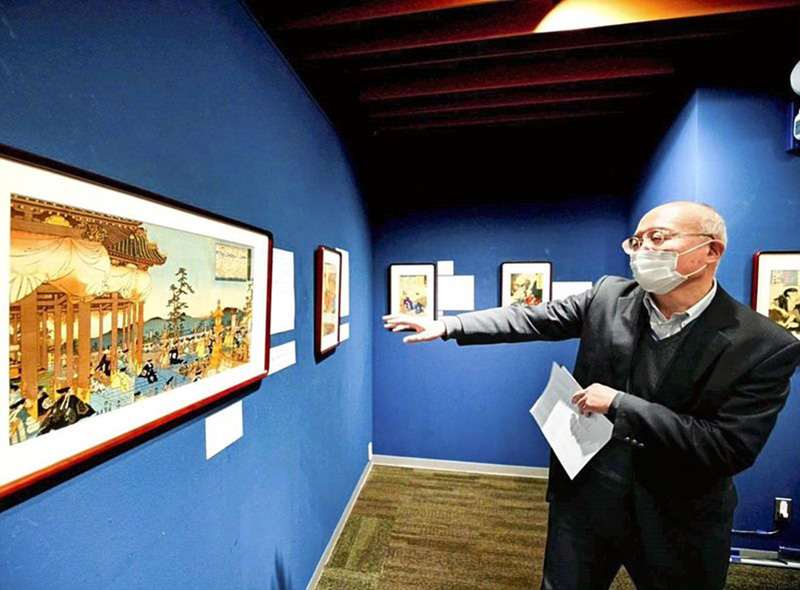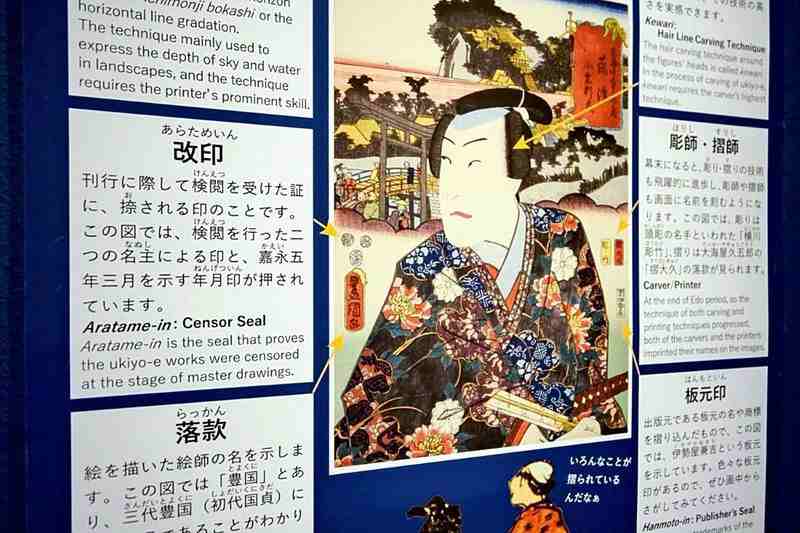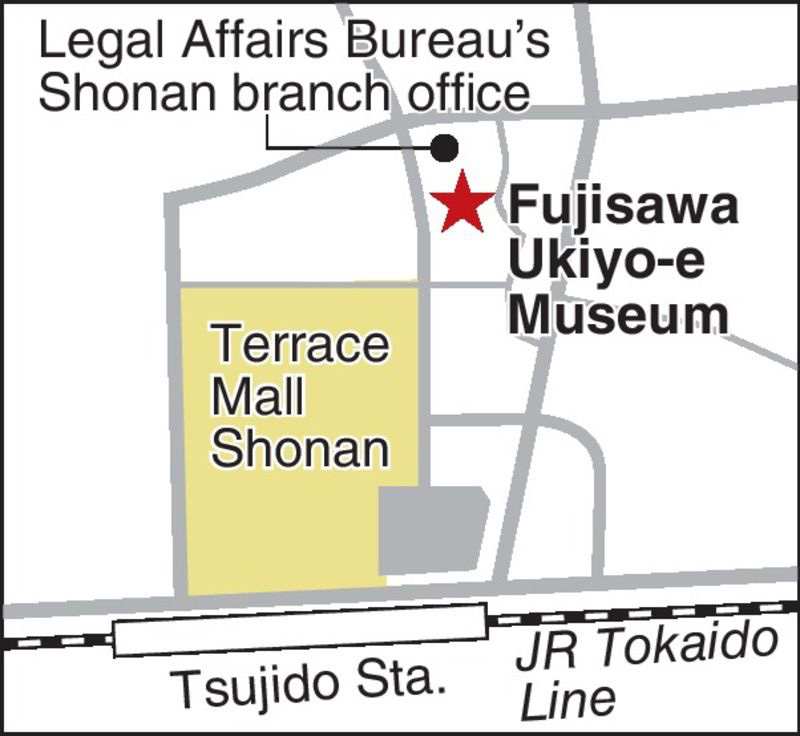
A museum worker gestures toward “Kamakura Ubakuka Shokoba no Zu” (1844) which depicts Minamoto no Yoritomo holding a memorial service for his father, Yoshitomo, in Kamakura.
15:38 JST, February 15, 2022
Entering the exhibition room at the Fujisawa Ukiyo-e Museum in Fujisawa, Kanagawa Prefecture, newcomers to the art form are offered helpful explanations about the marks on ukiyo-e as well as carving and printing techniques. One explanation states, for example, that ukiyo-e engravers and printers began to put their names on prints and paintings around the end of the Edo period (1603-1867). Visitors can also learn about hanmotoin, or the seal of the publisher, and aratamein, or the seal of the censor to show a work had been approved.
The museum is home to about 1,500 ukiyo-e related to the city and its vicinity, including Enoshima island, one of ukiyo-e artist Utagawa Hiroshige’s favorite motifs. Visitors can enjoy a variety of ukiyo-e made by famous artists.

One of the works from Utagawa Toyokuni II’s “Eight Views of Famous Places”
The exhibition room has one area where Hiroshige’s “Fifty-Three Stations of the Tokaido Road” series is on display. Hiroshige created more than 20 kinds of Tokaido-themed works, with the “Kyoka Tokaido” series featuring Tokaido-related kyoka poems and corresponding scenes among the works displayed at the museum.
The work “Fujisawa” depicts the Sakai River flowing toward Enoshima island; the Daigiri Bridge (now Yugyoji Bridge) over the river; and Mt. Oyama in Isehara in the prefecture, which attracted many worshippers during the Edo period, on the other side of the bridge. The work is the seventh in the “Kyoka Tokaido” series and features a kyoka poem about spring and a mountain in the distance.

A sugoroku board game based on Utagawa Hiroshige’s “Fifty-Three Stations of the Tokaido Road” series
“Night Rain at Oyama” is one of the most famous works in Utagawa Toyokuni II’s “Eight Views of Famous Places” series because of its superb depiction of rain. Looking at the ukiyo-e from a distance, one can see how terrible the weather is as the rain falls diagonally from the sky, pummeling the mountain. Closer up, one can get a sense of deep faith of the people at that time with the depiction of people struggling to climb the mountain to visit Ohyama-Afuri Shrine there.

A variety of information about ukiyo-e, including the engravers
A special exhibition introducing works depicting heroes and great warriors of the Kamakura period (late 12th century to 1333) was also to be held until Feb. 13 at the museum. Utagawa Sadahide’s “Kamakura Ubakuka Shokoba no Zu” (1844) depicts Minamoto no Yoritomo holding a memorial service for his father, Yoshitomo, in Kamakura after destroying the Taira clan in the Battle of Dannoura. Hojo Yoshitoki, Hiki Yoshikazu and Kudo Suketsune also are depicted in the ukiyo-e. The three are among the characters of NHK’s annual historical TV epic “The 13 Lords of the Shogun.”

Fujisawa Ukiyo-e Museum: 7F Cocco Terrace Shonan, 2-2-2 Tsujido Kandai, Fujisawa, Kanagawa Prefecture
Related Tags
"Features" POPULAR ARTICLE
-

Sanrio to Open Museum in Yamanashi Pref. Dedicated to Founder, Exhibits Include Hello Kitty, Other Characters
-

Autumn Foliage Surrounds Visitors to Tokyo’s Showa Kinen Park
-

My Daughter No Longer Speaks to Me, But I Want to See Her and My Grandchild
-

Kumamoto: Public Bath Refurbished as Library Where You Can Chat, Take Photos
-

Frozen Vegetables: Demand Rises for Convenient, Tasty Domestic Produce
JN ACCESS RANKING
-

Tokyo Economic Security Forum to Hold Inaugural Meeting Amid Tense Global Environment
-

Keidanren Chairman Yoshinobu Tsutsui Visits Kashiwazaki-Kariwa Nuclear Power Plant; Inspects New Emergency Safety System
-

Imports of Rare Earths from China Facing Delays, May Be Caused by Deterioration of Japan-China Relations
-

University of Tokyo Professor Discusses Japanese Economic Security in Interview Ahead of Forum
-

Japan Pulls out of Vietnam Nuclear Project, Complicating Hanoi’s Power Plans

























